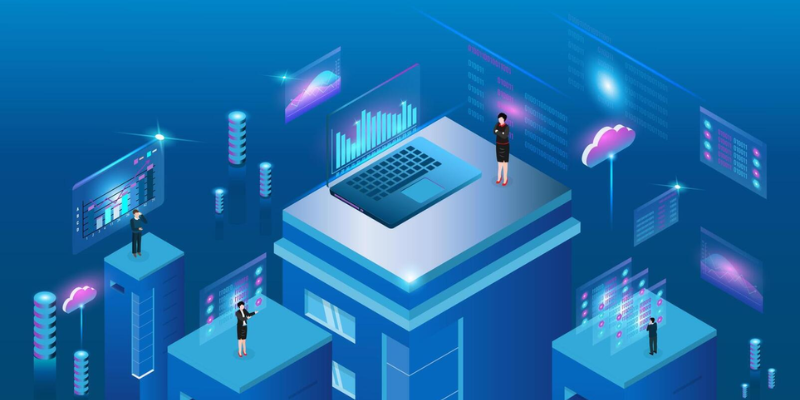Top Cloud Computing Terminologies Every Beginner Should Know

Cloud computing has gained traction in this modern digital age, where it is providing support to IT infrastructure that allows companies and people to access data, applicatios and services on the internet. If you are considering a career in cloud computing, working at a startup, or simply want to learn more about the technology behind your favorite apps, it is essential to familiarize yourself with key terminology.
The world of cloud computing might appear to the novice to be confusing at first especially with the plethora of jargons and terms that are used in it. Nonetheless, after getting acquainted with the general ideas, it will be much simpler to comprehend how the cloud operates and how it may be used fairly successfully. In this blog we will disintegrate some of the best cloud computing terminologies, which a beginner should understand.
1. Cloud Computing
Let’s begin with the fundamentals. Cloud computing, sometimes known as “the cloud,” is the online delivery of computer services, including networking, databases, servers, storage, software, and more. Instead of owning and maintaining physical servers, users can access and pay for only what they use, when they need it.
Cloud services are also increasingly used to integrate Data Science into Cloud Platforms, enabling scalable analytics, data pipelines, and real-time insights across industries.
2. IaaS, PaaS, and SaaS
These are the three primary service models in cloud computing:
- Virtualized computer resources are available online through Infrastructure as a Service, or IaaS.
- Platform as a Service (PaaS) is a platform that enables customers to develop, run, and manage applications. Examples include Heroku and Google App Engine.
- Software as a Service, or SaaS, is a subscription-based online software application delivery service. Gmail and Microsoft 365 are two examples.
Understanding these models helps you identify what level of control you have over the infrastructure and software.
3. Public Cloud, Private Cloud, and Hybrid Cloud
- Public Cloud: services that are accessible to anybody who want to acquire them on the public internet. AWS, Azure, and Google Cloud are a few examples.
- Private Cloud: Cloud infrastructure used exclusively by a single organization, offering more control and privacy.
- Hybrid Cloud: Combines public and private clouds, enabling data and applications to move between them for greater flexibility.
Organizations that adopt a combination of services often face the Complexities of Multi-Cloud Integration, including interoperability issues, cost optimization, and security challenges.
4. Virtualization
Virtualization is a foundational concept in cloud computing. It describes the process of building a virtualized version of a resource, such as a storage device or server. Multiple operating systems may operate on a same physical computer thanks to virtual machines, which boosts productivity and adaptability.
5. Containers
Unlike virtual machines, containers package an application and its dependencies together, but share the host OS. This makes them lightweight and faster to start. Docker is a popular container platform, and Kubernetes is widely used to orchestrate containerized applications.
6. Scalability and Elasticity
- Scalability is the capacity to scale resources in response to demand.
- Elasticity is the automated and dynamic scaling of resources to handle fluctuating workloads.
These features are what make cloud computing so powerful for businesses with changing needs.
7. Serverless Computing
Developers may create and execute apps using serverless computing without worrying about maintaining the infrastructure. You simply write your code and upload it to the cloud provider (e.g., AWS Lambda), and they handle the rest—scaling, patching, and maintaining the server.
If you’re eager to work on cloud-native development, practical exposure through Cloud Computing Courses in Chennai can make concepts like serverless computing easier to master.
8. Cloud Storage
Cloud storage is the model of storing data on remote servers accessed from the internet. Data is maintained, managed, and backed up by cloud providers. Examples include Amazon S3, Google Cloud Storage, and Dropbox.
9. Load Balancing
Load balancing is the process of dividing up incoming network traffic across several servers so that no one server is overwhelmed. Performance and availability are enhanced as a result. Many cloud providers offer built-in load balancing services.
10. API (Application Programming Interface)
APIs provide communication between various software programs. In cloud computing, APIs enable users to interact with cloud services programmatically, automating tasks like launching virtual machines or managing data.
11. Multi-Tenancy
A single instance of software or infrastructure that serves several clients (tenants) is said to be multi-tenancy. While each tenant’s data is safe and separated, the shared environment boosts productivity and lowers expenses.
12. Uptime and SLA
- Uptime is the amount of time a system is operational and available.
- SLA (Service Level Agreement) is an agreement between a service supplier and consumer that establishes criteria of good performance such as uptime guarantees.
High uptime and solid SLAs are essential when choosing a cloud provider.
13. Backup and Disaster Recovery
Cloud platforms often offer backup and disaster recovery services to ensure data can be restored after accidental deletion, hardware failure, or cyberattacks. These solutions are critical for business continuity.
14. Pay-As-You-Go
Pay as you go pricing is one of the great benefits of cloud computing. Costs are minimal because you will pay towards the resources and services that you use and hence it could be a great saving for a startup or small businesses.
The world of cloud computing is vast, but understanding the fundamental terminology is the first step toward mastering it. From knowing the difference between IaaS and SaaS to grasping concepts like virtualization, scalability, and serverless computing, these terms form the building blocks of your cloud knowledge.
With cloud technologies constantly changing, keeping you abreast and knowing about such things helps to navigate through projects more efficiently, make informed decisions, and yes, even cloud-based certifications or jobs. For a quicker progress on the way to knowing more and more, you can take up some practical and industry centered training on cloud computing at the Best Training Institute in Chennai, where you can get a first hand experience and some guru guidance in cloud computing. Therefore, as a student, IT expert, and/or a businessowner, take the time and learn these key terminologies in cloud computing and this would become your sexiest key towards pathway to cloud computing knowledge and power.



